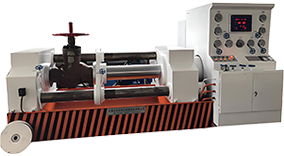Jun 25, 2025
Valve testing is a critical process in ensuring the safety, durability, and proper function of valves across various industries. Valves play a central role in controlling the flow of gases, liquids, and other substances under different operating pressures. Understanding the differences between low pressure and high pressure valve testing helps ensure that the correct testing procedures and equipment are used for each application. This article explores the main distinctions between these two testing approaches and highlights the role of equipment such as the High-Pressure Valve Test Stand and the Gate Valve Test Machine.

Purpose of Valve Testing
Both low pressure and high pressure valve testing aim to verify the valve’s ability to seal, hold pressure, and perform consistently under specific operating conditions. However, the testing environments and safety considerations differ significantly between these two methods.
Low Pressure Valve Testing Overview
Low pressure valve testing typically involves testing valves at pressures that are below standard service conditions. This type of testing is commonly used to detect visible leaks, verify basic sealing functions, and assess the valve’s structural integrity under small stress. The test pressure is usually just enough to confirm that the valve closes properly without introducing excessive forces.
Low pressure valve testing often uses air, water, or inert gases as the test medium. This testing is suitable for scenarios where valves will operate in low pressure systems, such as in certain water distribution networks, low-pressure gas pipelines, and ventilation systems.
Equipment like a Gate Valve Test Machine is often configured to accommodate both low and high pressure testing. For low pressure tests, the machine typically operates in a controlled environment, applying specific amounts of pressure while monitoring for leaks around the valve seat, stem, and body.
Common Low Pressure Testing Methods:
Air leak testing
Seat leakage testing at small pressure
Visual inspection for bubble formation
Functional opening and closing checks
Low pressure tests are generally less time-consuming and require fewer complex safety measures compared to high pressure tests.
High Pressure Valve Testing Overview
High pressure valve testing is designed for valves intended to operate under demanding pressure conditions. The High-Pressure Valve Test Stand is a dedicated system built to safely conduct tests at significantly elevated pressures. These tests simulate the harsh environments in which high pressure valves will eventually be installed, such as oil and gas pipelines, chemical plants, and high-pressure steam systems.
High pressure valve testing typically uses hydraulic fluids or water due to their incompressibility, which improves safety during the test. The High-Pressure Valve Test Stand must be engineered with robust clamping, reinforced test chambers, and precise pressure control to manage the intense forces involved in this process.
Common High Pressure Testing Methods:
Hydrostatic pressure testing
Burst pressure testing
Tightness testing under up to rated pressure
Seat and body leakage testing under elevated stress
These tests are usually longer in duration and require careful monitoring with safety barriers in place to protect operators and equipment.
Key Differences Between Low and High Pressure Valve Testing
Test Medium:
Low pressure testing often uses air or gas.
High pressure testing typically uses water or hydraulic fluids.
Testing Equipment:
Low pressure tests can be performed using standard equipment like the Gate Valve Test Machine with basic setups.
High pressure tests require specialized equipment such as the High-Pressure Valve Test Stand with enhanced safety features.
Safety Requirements:
Low pressure testing involves lower risk levels and smaller safety controls.
High pressure testing demands rigorous safety protocols due to the potential energy involved.
Test Objectives:
Low pressure tests focus on initial leakage detection and basic sealing performance.
High pressure tests aim to validate the valve’s ability to handle working pressures close to its rated capacity.
Applications:
Low pressure valve testing is commonly used in HVAC systems, water supply, and low-pressure gas lines.
High pressure valve testing is essential in high-demand industries like petrochemical processing, power generation, and high-pressure fluid control.
Both low pressure and high pressure valve testing play essential roles in ensuring valve reliability across different working environments. The Gate Valve Test Machine is versatile enough to be used for both pressure levels, while the High-Pressure Valve Test Stand is specifically designed to handle elevated pressures safely and accurately. Understanding the differences between these testing processes allows manufacturers and end users to choose the appropriate testing method and equipment for each valve application, ensuring system safety and long-term performance.